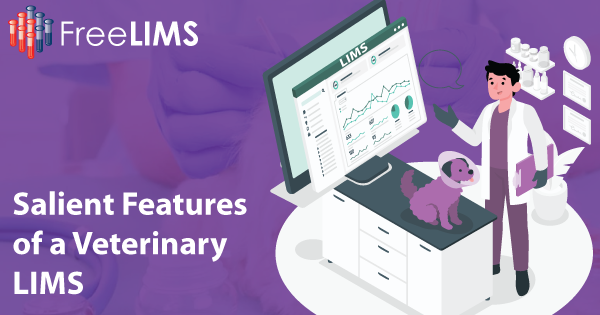The demand for veterinary services has skyrocketed in the last decade, driven by a significant rise in zoonotic and food-borne diseases. According to a recent report from Future Market Insights, revenues from veterinary services will surpass $244 billion by 2032, a 2.4X increase from 2022.
Laboratories play an important role in diagnosing and treating animal health issues. Veterinary Laboratory Information Management Systems (LIMS) have become indispensable to effectively manage the extensive data produced in these laboratories. A state-of-the-art Veterinary LIMS offers a range of features designed to streamline laboratory processes, ensure data accuracy, and enhance overall efficiency. This blog discusses five salient features of a state-of-the-art Veterinary LIMS.
A veterinary LIMS:
1. Enables Labs to Configure Breed-Specific Test Limits
A cutting-edge veterinary LIMS distinguishes itself with the crucial feature of breed-specific test limits. Unlike human clinical testing, veterinary laboratories receive samples from diverse animal breeds, each necessitating distinct test parameters. A good veterinary LIMS facilitates the seamless configuration and management of breed or species-specific test limits. This dynamic functionality allows easy adjustment of test limits based on the animal’s species, breed, age, or life stage. This adaptability ensures that a single test accommodates multiple limits for various species and breeds, streamlining the testing process and enhancing efficiency for veterinary lab professionals. Furthermore, this functionality enables the flagging of out-of-specification test results that lie outside the reference limits.
2. Supports Culture & Sensitivity Testing
In veterinary laboratories, culture and sensitivity testing is critical in identifying and treating microbial infections. This common test type involves microbiological culture tests to pinpoint the microorganisms causing infections, followed by sensitivity tests that determine the most effective treatments against the identified organisms. While ensuring seamless support for such tests, a good veterinary LIMS empowers veterinarians with a comprehensive view of the best antimicrobial agents to combat specific bacterial infections. Beyond its resemblance to spreadsheet functionalities, a LIMS ensures data integrity by saving results in an audit log, preventing the overwriting of entered results. This robust feature allows for the retrieval of historical data, even in cases where results have been modified. This is a critical advantage distinguishing it from traditional spreadsheets.
3. Allows Manual Differential Testing
Despite its seemingly straightforward nature, manual differential testing is a complex process. However, it plays a vital role in diagnosing animal health issues. This test method involves manually counting white blood cells in a blood sample, providing valuable insights into the animal’s health. Using preset keys on the computer keyboard’s numeric keypad, the count is meticulously incremented. Setting minimum and maximum count thresholds with alerts signaling when these thresholds are reached further refines the process. Thresholds, whether minimum or maximum, hold significance in manual differential testing. Once a specific proportion and quantity are reached, it signifies a definitive result, allowing the technician to proceed to the next sample.
4. Enables Sample Pooling
Sample pooling empowers laboratories to screen combined samples in a single test, where a negative result indicates that all samples within that pool are negative, saving resources and time. A veterinary LIMS must have the functionality to support sample pooling and manage results generated from sample pooling. Sample pooling enhances the overall efficiency of the laboratory and is instrumental in promptly assessing the health status of animal populations.
5. Manages Client-Specific Test Requests and Invoicing
Veterinary laboratories often need to capture additional information during sample accessioning, including detailed animal information, owner particulars, and the specific veterinary practice or clinician requesting the testing. A good LIMS offers a flexible solution that is tailored to the precise needs of veterinary labs, facilitating the capture of all relevant details with the ability to quickly retrieve them when needed. Upon completion of testing, the LIMS can seamlessly generate a test report and an invoice for clients, streamlining administrative tasks and ensuring accurate and transparent communication of costs incurred for the services rendered.
In addition to this, veterinary LIMS software needs to possess important features common to other LIMS. A key feature of a modern veterinary LIMS is robust sample tracking and chain of custody management. It should also be able to integrate with Electronic Health Records (EHR) systems, making it seamless for veterinary professionals to access and update patient records. Lastly, it should have appropriate quality control measures in place, assessing instrument performance and ensuring compliance with industry standards and regulations.
Benefits of Cloud-Hosted Veterinary LIMS Software
Cloud-hosted veterinary LIMS software offers numerous benefits. For starters, it provides veterinary laboratories with the flexibility to expand their operations seamlessly as their needs grow without the need for significant hardware investments. This scalability ensures laboratories can adapt to changes in workload and testing requirements more efficiently. Moreover, cloud-hosted LIMS solutions offer anytime, anywhere access to data for authorized personnel. This enables veterinarians and lab staff to access critical information remotely. It also fosters collaboration among geographically dispersed teams. This paves the way for quicker response to urgent cases, ultimately leading to improved patient care. Furthermore, cloud hosting provides robust security measures and data backup options.
Conclusion
As veterinary medicine continues to evolve, the need for a state-of-the-art LIMS continues to gain preeminence. Veterinary LIMS software must have the functionality to set test limits specific to breeds, facilitate culture and sensitivity testing, enable manual differential testing, support sample pooling, and allow for client-specific test requests and invoicing. A cloud-hosted veterinary LIMS empowers laboratories to securely manage data in the cloud, providing 24/7 accessibility from any location, eliminating the need for upfront investment, and enhancing collaboration among all stakeholders. Implementing such a system not only benefits the laboratory but also contributes to better animal care and welfare.


